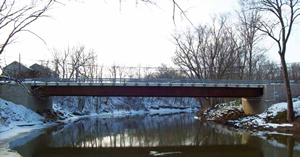 |
As noted in the introductory report from the National Association of County Engineers (NACE) 2011 event here in Minneapolis, Minnesota, the concurrent sessions presented attendees with some difficult choices on how they wanted to divide their time. Monday afternoon’s second block of sessions was particularly tough. While the green tech in pavement preservation and gravel road design sessions were intriguing (especially with the possible inclusion of geotextile and geogrid content in the unpaved road design dialogue), it was the “Construction of Geosynthetic Reinforced Soil Integrated Bridge System (GRS-IBS)” session that called.
Ron Bygness, editor of Geosynthetics Magazine, agreed. He was also in attendance; as was Warren Schlatter, county engineer from Defiance County, Ohio. It was nice to meet Warren outside of random email exchanges. His county’s bridge construction projects have been well-documented and Schlatter has been recognized with awards. Prior to the sessions beginning, Ron and I got a chance to talk to him about his utilization of GRS technology, and he reports that 10% of his county’s bridges are now GRS.
(Odd fact of the day: Ohio is the only state in which county engineers must be publicly elected. Schlatter is on his second term.)
Moderated by Fillmore County, Minnesota’s engineer John Grindeland, the well-attended GRS session featured three speakers: Mike Adams (FHWA), Toby Bogart (Saint Lawrence County, NY) and Brian Keierleber (Buchanan County, Iowa).
Mike’s presentation was fast and furious. With many slides and statistics, and with plenty of supporting material available openly online through the FHWA’s Every Day Counts (EDC) initiative, Adams focused more on introducing the topic of GRS-IBS to the room and left more time for his fellow speakers to focus on their project experiences.
 |
Some of the notes that resonated best from Mike’s introduction:
- There are roughly 45 bridge abutment projects in the US that have utilized the GRS approach, 28 of which have used the GRS-IBS method that FHWA’s EDC initiative is teaching
- These bridges have been built in 10 days–the entire bridge!
- Cost savings with the GRS-IBS approach vs. traditional methods are in the range of 20-60%
- For conservative design reasons, the current published limitations for the system are for 140 ft. spans and abutments up to 30 ft. high
New York’s Toby Bogart followed, echoing and furthering Mike’s notes. He revealed that he had not heard of the GRS approach when he started working for Saint Lawrence County in June 2009; yet, by October 2009 they had built their first one. This highlighted how immensely useful and focused the training in this construction method is, how quickly it can be incorporated. Saint Lawrence County liked that first project so well that four more projects were constructed in 2010 in this style. In 2011, 7 GRS projects have been planned. In a normal season, the county would build or rebuild three bridges. This year: seven. And they will not necessarily spend any more than in previous years, as the GRS system for Toby’s county has come in, on average, at 50% the cost of traditional approaches.
Additional points of interest in Toby’s presentation involved how they have been able to avoid special permitting from the state Department of Environmental Conservation (NYSDEC) because his county has not disturbed the pre-existing, stable concrete scour protection structures where they’ve rebuilt those old jack arch construction bridges. Instead, they’ve started construction of the GRS systems 10 or 15 ft. back. This means they aren’t disturbing waterways and do not need special coffer dams or anything greater than a general permit. The brief construction period (10 days) has been essential.
He estimates that close to half of the 250 bridges in his county can be converted to GRS designs.
Iowa’s Brian Keierleber closed out the session with slightly different designs–GRS structures he came to before he’d been fully exposed the FHWA approach. Brian’s lively presentation highlighted some of critical reasons for needing to adopt these faster, more economical, and stronger designs. Rural areas, in particular, are dealing with well-aged infrastructures and increasingly heavier traffic. He showed images of bridges in his county constructed in the 1870s. He showed buckled wooden bridges–that farmers had asked him to leave until after spring planting. He showed reports of 770-gal. trucks of manure crossing 22-ton bridges, semis crossing 3-ton bridges.
Researchers from Iowa State University have gotten involved in Buchanan County’s GRS projects and have installed monitoring equipment. ISU’s sensors even provided one of the most interesting slides from the session. On what looked like a time-stamped graphic of load response, Keierleber pointed out that these time marks were from a single day’s construction. The loads recorded were regular, with spikes for particular phases of the construction. Between two key points, an hour lag in load could be observed. “I think this must have been lunch,” Keierleber said.
Humor aside, it is clear that modernization is in great need, and on a fantastic scale. The many, small bridges essential to American infrastructure–the bridges so often overlooked in popular infrastructure discussions–must be updated to keep road systems safe and efficient, to keep many communities connected, and to properly support agriculture, manufacturing, and many other sectors of the economy.
LOOKING AHEAD
Tuesday at NACE will include sessions on professional development, effective lobbying, and dust control in the morning; followed by tribal issues in transportation, going green horizontally and vertically, and a much-anticipated GRS case study from Warren Schlatter in a session on “Short Span Steel Bridges.”
Chris Kelsey is the editor of Geosynthetica. He can be reached at chris@geosynthetica.net.











